Input interpretation

diphenyliodonium 9, 10-dimethoxyanthracene-2-sulfonate
Basic properties
![molar mass | 598.5 g/mol formula | C_28H_23IO_5S empirical formula | C_28O_5S_I_H_23 SMILES identifier | COC1=C2C=CC(=CC2=C(C3=CC=CC=C31)OC)S(=O)(=O)[O-].C4=CC=C(C=C4)[I+]C5=CC=CC=C5 InChI identifier | InChI=1/C16H14O5S.C12H10I/c1-20-15-11-5-3-4-6-12(11)16(21-2)14-9-10(22(17, 18)19)7-8-13(14)15;1-3-7-11(8-4-1)13-12-9-5-2-6-10-12/h3-9H, 1-2H3, (H, 17, 18, 19);1-10H/q;+1/p-1/fC16H13O5S.C12H10I/q-1;m InChI key | ZMCBPOWGXHULPT-UHFFFAOYSA-M](../image_source/57b2d3aad09ad6b2ae2e210bc39fc71b.png)
molar mass | 598.5 g/mol formula | C_28H_23IO_5S empirical formula | C_28O_5S_I_H_23 SMILES identifier | COC1=C2C=CC(=CC2=C(C3=CC=CC=C31)OC)S(=O)(=O)[O-].C4=CC=C(C=C4)[I+]C5=CC=CC=C5 InChI identifier | InChI=1/C16H14O5S.C12H10I/c1-20-15-11-5-3-4-6-12(11)16(21-2)14-9-10(22(17, 18)19)7-8-13(14)15;1-3-7-11(8-4-1)13-12-9-5-2-6-10-12/h3-9H, 1-2H3, (H, 17, 18, 19);1-10H/q;+1/p-1/fC16H13O5S.C12H10I/q-1;m InChI key | ZMCBPOWGXHULPT-UHFFFAOYSA-M
Structure diagram
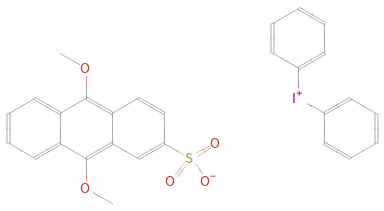
Structure diagram
Quantitative molecular descriptors
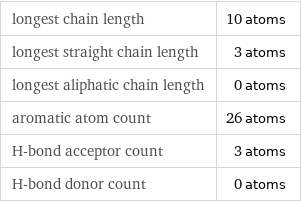
longest chain length | 10 atoms longest straight chain length | 3 atoms longest aliphatic chain length | 0 atoms aromatic atom count | 26 atoms H-bond acceptor count | 3 atoms H-bond donor count | 0 atoms
Elemental composition

Find the elemental composition for diphenyliodonium 9, 10-dimethoxyanthracene-2-sulfonate in terms of the atom and mass percents: atom percent = N_i/N_atoms × 100% mass percent = (N_im_i)/m × 100% Plan: • Write the chemical formula and gather atomic masses from the periodic table. • Determine values for N_i, m_i, N_atoms and m using these items. • Finally, compute the percents and check the results. Write the chemical formula: C_28H_23IO_5S Use the chemical formula to count the number of atoms, N_i, for each element and find the total number of atoms, N_atoms, per molecule: | number of atoms C (carbon) | 28 O (oxygen) | 5 S (sulfur) | 1 I (iodine) | 1 H (hydrogen) | 23 N_atoms = 28 + 5 + 1 + 1 + 23 = 58 Divide each N_i by N_atoms to calculate atom fractions. Then use the property that atom fractions must sum to one to check the work: | number of atoms | atom fraction C (carbon) | 28 | 28/58 O (oxygen) | 5 | 5/58 S (sulfur) | 1 | 1/58 I (iodine) | 1 | 1/58 H (hydrogen) | 23 | 23/58 Check: 28/58 + 5/58 + 1/58 + 1/58 + 23/58 = 1 Compute atom percents using the atom fractions: | number of atoms | atom percent C (carbon) | 28 | 28/58 × 100% = 48.3% O (oxygen) | 5 | 5/58 × 100% = 8.62% S (sulfur) | 1 | 1/58 × 100% = 1.72% I (iodine) | 1 | 1/58 × 100% = 1.72% H (hydrogen) | 23 | 23/58 × 100% = 39.7% Look up the atomic mass, m_i, in unified atomic mass units, u, for each element in the periodic table: | number of atoms | atom percent | atomic mass/u C (carbon) | 28 | 48.3% | 12.011 O (oxygen) | 5 | 8.62% | 15.999 S (sulfur) | 1 | 1.72% | 32.06 I (iodine) | 1 | 1.72% | 126.90447 H (hydrogen) | 23 | 39.7% | 1.008 Multiply N_i by m_i to compute the mass for each element. Then sum those values to compute the molecular mass, m: | number of atoms | atom percent | atomic mass/u | mass/u C (carbon) | 28 | 48.3% | 12.011 | 28 × 12.011 = 336.308 O (oxygen) | 5 | 8.62% | 15.999 | 5 × 15.999 = 79.995 S (sulfur) | 1 | 1.72% | 32.06 | 1 × 32.06 = 32.06 I (iodine) | 1 | 1.72% | 126.90447 | 1 × 126.90447 = 126.90447 H (hydrogen) | 23 | 39.7% | 1.008 | 23 × 1.008 = 23.184 m = 336.308 u + 79.995 u + 32.06 u + 126.90447 u + 23.184 u = 598.45147 u Divide the mass for each element by m to calculate mass fractions. Then use the property that mass fractions must sum to one to check the work: | number of atoms | atom percent | mass fraction C (carbon) | 28 | 48.3% | 336.308/598.45147 O (oxygen) | 5 | 8.62% | 79.995/598.45147 S (sulfur) | 1 | 1.72% | 32.06/598.45147 I (iodine) | 1 | 1.72% | 126.90447/598.45147 H (hydrogen) | 23 | 39.7% | 23.184/598.45147 Check: 336.308/598.45147 + 79.995/598.45147 + 32.06/598.45147 + 126.90447/598.45147 + 23.184/598.45147 = 1 Compute mass percents using the mass fractions: Answer: | | | number of atoms | atom percent | mass percent C (carbon) | 28 | 48.3% | 336.308/598.45147 × 100% = 56.20% O (oxygen) | 5 | 8.62% | 79.995/598.45147 × 100% = 13.37% S (sulfur) | 1 | 1.72% | 32.06/598.45147 × 100% = 5.357% I (iodine) | 1 | 1.72% | 126.90447/598.45147 × 100% = 21.21% H (hydrogen) | 23 | 39.7% | 23.184/598.45147 × 100% = 3.874%
Elemental oxidation states

The first step in finding the oxidation states (or oxidation numbers) in diphenyliodonium 9, 10-dimethoxyanthracene-2-sulfonate is to draw the structure diagram. Next set every oxidation number equal to the atom's formal charge: In diphenyliodonium 9, 10-dimethoxyanthracene-2-sulfonate hydrogen is not bonded to a metal with lower electronegativity, so it will have an oxidation state of +1. Any element bonded to hydrogen gains the bonding electrons, decreasing their oxidation state by 1 for every bond: With hydrogen out of the way, look at the remaining bonds. There are 2 carbon-iodine bonds, 4 carbon-oxygen bonds, 1 carbon-sulfur bond, 3 oxygen-sulfur bonds, and 28 carbon-carbon bonds. For each of these bonds, assign the bonding electrons to the most electronegative element. First examine the carbon-iodine bonds: element | electronegativity (Pauling scale) | C | 2.55 | I | 2.66 | | | Since iodine is more electronegative than carbon, the electrons in these bonds will go to iodine. Decrease the oxidation number for iodine in every highlighted bond (by 1 for single bonds, 2 for double bonds, and 3 for triple bonds), and increase the oxidation number for carbon accordingly: Next look at the carbon-oxygen bonds: element | electronegativity (Pauling scale) | C | 2.55 | O | 3.44 | | | Since oxygen is more electronegative than carbon, the electrons in these bonds will go to oxygen: Next look at the carbon-sulfur bond: element | electronegativity (Pauling scale) | C | 2.55 | S | 2.58 | | | Since sulfur is more electronegative than carbon, the electrons in this bond will go to sulfur: Next look at the oxygen-sulfur bonds: element | electronegativity (Pauling scale) | O | 3.44 | S | 2.58 | | | Since oxygen is more electronegative than sulfur, the electrons in these bonds will go to oxygen: Next look at the carbon-carbon bonds: element | electronegativity (Pauling scale) | C | 2.55 | C | 2.55 | | | Since these elements are the same the bonding electrons are shared equally, and there is no change to the oxidation states: Now summarize the results: Answer: | | oxidation state | element | count -2 | C (carbon) | 2 | O (oxygen) | 5 -1 | C (carbon) | 17 | I (iodine) | 1 0 | C (carbon) | 4 +1 | C (carbon) | 5 | H (hydrogen) | 23 +4 | S (sulfur) | 1
Orbital hybridization
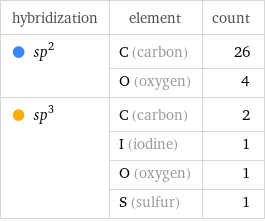
hybridization | element | count sp^2 | C (carbon) | 26 | O (oxygen) | 4 sp^3 | C (carbon) | 2 | I (iodine) | 1 | O (oxygen) | 1 | S (sulfur) | 1
Structure diagram
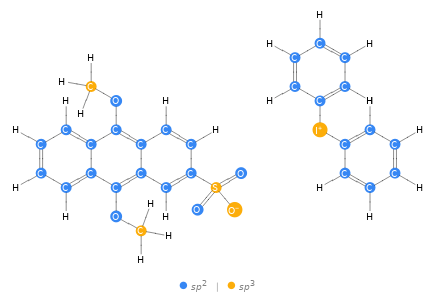
Orbital hybridization Structure diagram
Topological indices
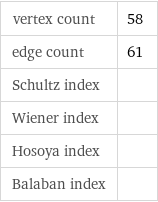
vertex count | 58 edge count | 61 Schultz index | Wiener index | Hosoya index | Balaban index |